To my surprise, in the last three weeks, I have gotten a few questions about the price and value of the Italian 2002 2-euro coin, which, although some think it bears the portrait of a Native American, is that of Dante, and is accompanied by the initials RI of the Italian Republic, R for Rome, and MCC for Maria Carmela Colaneri. After checking second-hand platforms, it has become clear to me that we are facing a new numismatic hoax.

So, before the confusion spreads further, let’s talk a little about it: let’s see how much the 2002 Italian 2-euro coins are worth and why some people are selling them for so much.
How much is the 2002 Italy 2-euro coin worth?
The value of an Italian 2-euro coin from 2002 that you have found in the change is 2 euros, it doesn’t have any extra value. That’s around 2 dollars.
If you are here, you have probably arrived via Google because you found one in your change and looked up its value. If you found it in your change, the coin has circulated, and therefore, as a general rule, a collector will not want it. Generally, collectors only want brand-new euro coins.

If it is completely new, what is known as “uncirculated,” the price of the coin goes up a bit: around 5 dollars, according to the Leuchtturm euro catalog.
But it cannot have any signs of use or wear. And it also cannot be cleaned: the average coin collector can see if a coin has been cleaned, because the brightness of the piece is different.

Despite what you might think, the price and value of a coin depend only on one thing: the demand it has among collectors. If the demand exceeds the supply, the coin’s price goes up. If the demand is lower than the supply, the price goes down.
With that in mind, let’s look at the supply:
Italy was a founding member of the Eurozone, and the first euro coins and banknotes began circulating on January 1, 2002. That means that, for that year, they had to mint enough coins for the entire population of the country and to be able to replace their previous currency, the lira, without any problem.
Here’s how many euro coins were minted to introduce the single currency in Italy in 2002:
| Coin | Mintage |
|---|---|
| 1 cent | 1,348,599,500 |
| 2 cents | 1,098,866,250 |
| 5 cents | 1,341,442,204 |
| 10 cents | 1,142,083,000 |
| 20 cents | 1,411,536,000 |
| 50 cents | 1,136,418,000 |
| 1 euro | 965,725,300 |
| 2 euros | 463,402,200 |
The mintage of the Italian 2002 2-euro coin was about 463.4 million pieces.
Knowing that the value of a coin goes up when there is more demand than supply, this means that for the value of used Italian 2-euros from 2002 to rise, there would have to be more than 463.4 million euro coin collectors.
And no, there aren’t: that number is greater than the total population of the European Union, which as of January 1, 2022, was about 446.8 million people.
As you can imagine from the figures, most euro coin collectors already have this coin, and those who do not want can easily find it brand new.
That is why the value of that coin you found in the change is just the facial one.
In fact, the complete set of Italian coins from 1 cent to 2 euros from 2002 can be purchased for less than 10 euros.
So why is it being sold for so much on eBay?
This case is similar to that of the 2008 Cyprus 2-euro coin (in fact, you’ll see that the reasoning for the value of both coins is essentially the same) which, although not as outrageous as the 2002 “S” Greek 2-euro coin, looks like it could quickly spiral out of control.
As you can see in the photos accompanying this post, on some second-hand buying and selling websites you can already see certain prices for the 2002 Italian 2 euro coin that are not in line with numismatic reality.

The crux of the matter is that people can ask as much as they want for their possessions. But that doesn’t mean someone will pay for it.
Imagine my car is a run-of-the-mill Toyota Corolla that, to make matters worse, is 7 years old. And I want to sell it. So I go on Craigslist, post an ad, and ask for $17 million for it. Can I do that? Sure. Will someone buy it? I highly doubt it.

So why do they ask so much for the coin? Well, sometimes it’s because of ignorance, and sometimes it’s because of dishonesty. More or less everyone has an intuitive notion of how much a car is worth, but not many people outside of numismatics know how much a coin is worth.
If we see a Corolla for $17 million, we laugh it off because we know it’s absurd. If we see a coin for $17 million, we check our wallets to see if we have it. And that’s how numismatic hoaxes start, like this one about the value of the 2002 Italian 2 dollar coin.